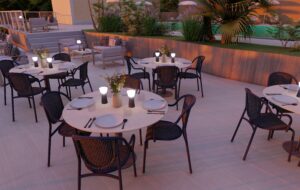|
|
||
|
The City of Culture of Galicia, a massive project by Peter Eisenman looming over Santiago de Compostela, recently opened its doors to its first visitors. The complex of libraries, archives, museums, concert halls and galleries is one of the last of a generation of European cultural buildings and a grand statement of a lifetime of architectural ideas. With Frank Gehry’s Guggenheim Museum Bilbao often seen as the first, a number of “iconic” civic and cultural projects were built in the last years of the 20th century, commissioned from architects such as Richard Rogers (the Millennium Dome) and Enric Miralles (the Scottish Parliament). The City of Culture shares with these buildings a rapidly changing brief, near-exponentially increasing costs and political controversy, but whereas Holyrood and the Dome are long complete and settled into their locations with varying degrees of success, the City of Culture still remains only partially finished over a decade after its birth, in a country badly hammered by the global recession. If it is difficult to see the City of Culture outside its status as the whitest of elephants, it is still a remarkable work of architecture. The overall effect of the building is that of a massive artificial landscape into which canyons and streets have been sliced. The rearing form is based on computer deformations of the street pattern of the medieval town of Santiago de Compostela, superposed with various structural, programmatic and diagrammatic grids. These grids are manifested across the building in varying degrees – from slight variations in the stone cladding to the deep channels that separate the various programmes. It’s a dizzyingly complex tangle of elements, each seemingly following its own logic. The project is a cornucopia of Eisenman’s ideas: in abundance are the grids and programmatic awkwardness of his earlier work (House VI, Connecticut, 1975), including his famous stray columns; the studies in artificial archaeology (Wexner Centre, Ohio, 1989), wherein historical context reappears in a transfigured form; the interpenetration of multiple forms (Aronoff Centre, Ohio, 1996) and the digital experiments in “folding” that have been his primary interest for the last 20 years. Whereas Eisenman buildings used to be primarily composed of angles and facets, this building swoops and twists around, its grids bent and deformed. It takes the extreme abstraction of Eisenman’s theme of “Architecture” as a language that refers only to itself, and attempts to combine it with something more contextual, mimicking local architecture in the stone cladding and narrow “streets”. This contextual abstraction is achieved with great finesse at Miralles’ Scottish Parliament, which is filled with references to Scottish architecture and culture, but perhaps Eisenman is too addicted to his dogmatic system to pull it off properly here. That said, if and when it is ever completed, and if it is able to transcend its own troubled cultural context, the City of Culture of Galicia might yet prove to be Eisenman’s masterwork. |
Image Inigo Bujedo Aguirre
Words Douglas Murphy |
|
|
||



















